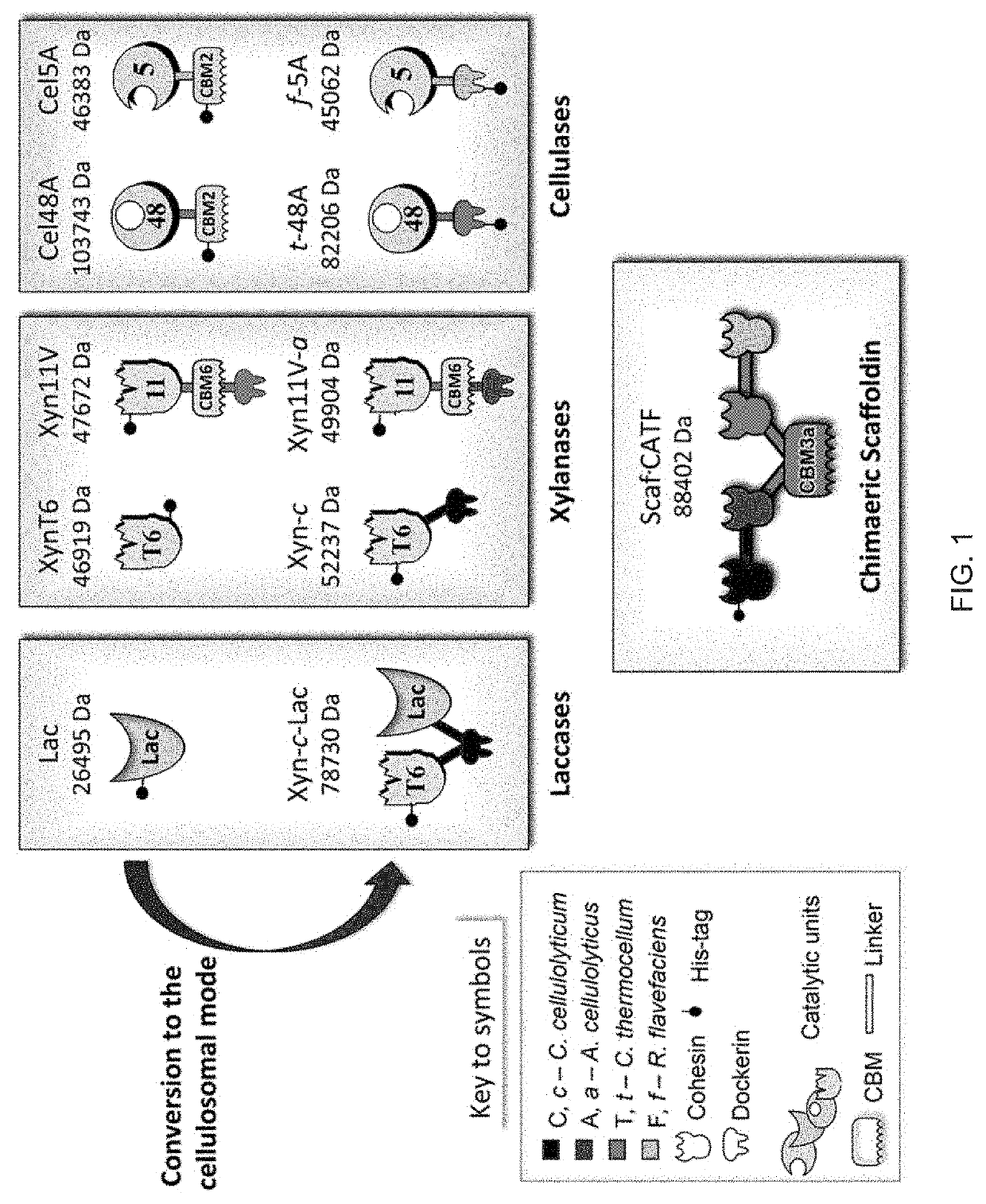Enzyme complex for lignocellulosic material degradation
a technology of enzyme complexes and lignocellulosic materials, which is applied in the field of biomass degrading enzyme complexes, can solve the problems of ineffective current techniques for removing lignin from biomass, limiting the accessibility of enzymes or chemicals, and lignin is mostly considered a hindran
- Summary
- Abstract
- Description
- Claims
- Application Information
AI Technical Summary
Benefits of technology
Problems solved by technology
Method used
Image
Examples
example 1
and Methods
[0195]Cloning:
[0196]Recombinant laccases were cloned by using a two-step restriction free procedure [Unger, T. et al., J Struct Biol, 2010, 172, 34-44]. The plasmids and primers used for the restriction-free cloning are listed in Table 2. Other enzymes and scaffoldin were cloned using restrictions enzymes.
TABLE 2PrimarySecondaryVectorForward primerReverse primerPCRPCRname(5′-3′)(5′-3′)templatetemplatepETduet-LactataccatggtgacgggcacggtgctcgagtgggaccT. fusca YXpETduetcgt (SEQ ID No. 21)ctccag (SEQ IDgenomic DNANo. 22)pETduet-c-LaccggttcgccggatatgtctggggtggcagcagcctagpET21a-pETduet-agggtcccaactagtcctgtagttaattaagctgcttaagXy143-clLacattgtat (SEQ ID No.gtagcttacttacc23)(SEQ ID No. 24)pETduet-atgggcagcagccatcaccaccctggaagtacaggttpET9d-Xyn-cpETduet-c-Xyn-c-LacatcatcaccacaagaatgcattcacccgcggatttgtgLacgattcctatgcgaaaaaacctgtcgataatagcccaata(SEQ ID No. 25)tgcggg (SEQ IDNo. 26)pET28aTATACCATGGcacagtcacctcggccgagtcC.pET28at48-Atcaccatcaccatcacgcagtgtggccgggtacctctgtthermocellumb-48At...
example 2
[0209]Conversion of the Selected Enzymes to the Cellulosomal Mode:
[0210]In this study two T. fusca cellulases were used, the family 5 endoglucanase Cel5A and exoglucanase Ce148A, together with Clostridium thermocellum xylanase Xyn11V, which were integrated into a designer cellulosome. This combination of enzymatic activities was shown to be highly synergistic and efficient for the simultaneous hydrolysis of cellulose and hemicellulose. This complex was used as a base to evaluate the benefits of the incorporation in designer cellulosomes of a lignin-modifying enzyme, T. fusca laccase-like Tfu_1114 (hereafter termed “Lac”).
[0211]In order to convert T. fusca enzymes to the cellulosomal mode, dockerin modules originating from different bacterial species and showing different binding specificities were used. T. fusca Ce148A and Cel5A were fused at their N-termini with dockerins originated from Clostridium thermocellum and Ruminococcus flavefaciens, and termed “t-48A” (SEQ ID No. 4) and “...
example 3
l Exemplary Embodiment
[0238]The enzymatic activity of two exemplary designer cellulosomes complexes, according to some embodiments of the present invention, containing three scaffoldins and either four or five enzymes, were prepared and assayed on two agrofood waste products, brewer's spent grain and apple pomace.
[0239]Enzyme activity was measured on 2% biomass at 30° C. and pH 5 after 72 hours of incubation period, and the results are presented in FIG. 9. Enzymatic activity is defined as mM soluble reducing sugars following the 72 hours reaction period. Each reaction was performed in triplicate, and standard deviations are indicated.
[0240]FIG. 9 presents a plot of comparative enzymatic activity of designer cellulosomes with an addition of the free Xyn-c-Lac (marked “A”), or containing the Xyn-c-Lac, according to some embodiments of the present invention (marked “B”) on degradation of brewer's spent grain and apple pomace.
[0241]The four enzymes containing designer cellulosome (marke...
PUM
| Property | Measurement | Unit |
|---|---|---|
| Affinity | aaaaa | aaaaa |
Abstract
Description
Claims
Application Information
 Login to View More
Login to View More - R&D
- Intellectual Property
- Life Sciences
- Materials
- Tech Scout
- Unparalleled Data Quality
- Higher Quality Content
- 60% Fewer Hallucinations
Browse by: Latest US Patents, China's latest patents, Technical Efficacy Thesaurus, Application Domain, Technology Topic, Popular Technical Reports.
© 2025 PatSnap. All rights reserved.Legal|Privacy policy|Modern Slavery Act Transparency Statement|Sitemap|About US| Contact US: help@patsnap.com



